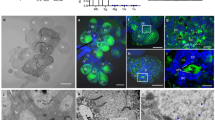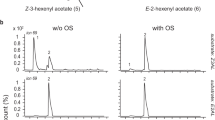A new weapon emerges in the evolutionary arms race between plants and herbivores.
Abstract
Blood-feeding arthropods secrete special salivary proteins that suppress the defensive reaction they induce in their hosts1,2. This is in contrast to herbivores, which are thought to be helpless victims of plant defences elicited by their oral secretions3,4. On the basis of the finding that caterpillar regurgitant can reduce the amount of toxic nicotine released by the tobacco plant Nicotiana tabacum5, we investigate here whether specific salivary components from the caterpillar Helicoverpa zea might be responsible for this suppression. We find that the enzyme glucose oxidase counteracts the production of nicotine induced by the caterpillar feeding on the plant.
This is a preview of subscription content, access via your institution
Access options
Subscribe to this journal
Receive 51 print issues and online access
$199.00 per year
only $3.90 per issue
Buy this article
- Purchase on Springer Link
- Instant access to full article PDF
Prices may be subject to local taxes which are calculated during checkout


Similar content being viewed by others
References
Felton, G. W. & Eichenseer, H. Induced Plant Defences Against Pathogens and Herbivores (Am. Phytopathol. Soc., St Paul, Minnesota, 1999).
Ribeiro, J. M. C. Regulatory Mechanisms in Insect Feeding (Chapman & Hall, New York, 1995).
Mattiacci, L., Dicke, M. & Posthumus, M. A. Proc. Natl Acad. Sci. USA 92, 2036–2040 (1995).
Alborn, H. T. et al. Science 276, 945–949 (1997).
Kahl, J. et al. Planta 210, 336–342 (2000).
Eichenseer, H., Mathews, M. C., Bi, J. L., Murphy, J. B. & Felton, G. W. Arch. Insect Biochem. Physiol. 42, 99–109 (1999).
Saunders, J. A. & Blume, D. E. J. Chromatogr. 205, 147–154 (1981).
Author information
Authors and Affiliations
Corresponding author
Rights and permissions
About this article
Cite this article
Musser, R., Hum-Musser, S., Eichenseer, H. et al. Caterpillar saliva beats plant defences. Nature 416, 599–600 (2002). https://doi.org/10.1038/416599a
Issue Date:
DOI: https://doi.org/10.1038/416599a
This article is cited by
-
Endocytosis-mediated entry of a caterpillar effector into plants is countered by Jasmonate
Nature Communications (2023)
-
Plant Variety, Mycorrhization, and Herbivory Influence Induced Volatile Emissions and Plant Growth Characteristics in Tomato
Journal of Chemical Ecology (2023)
-
Caterpillar Salivary Glucose Oxidase Decreases Green Leaf Volatile Emission and Increases Terpene Emission from Maize
Journal of Chemical Ecology (2023)
-
Plant defences and spider-mite web affect host plant choice and performance of the whitefly Bemisia tabaci
Journal of Pest Science (2023)
-
Alteration in the developmental physiology of Maruca vitrata (Fabricius) on jasmonic acid and salicylic acid treated pigeonpea
Arthropod-Plant Interactions (2023)
Comments
By submitting a comment you agree to abide by our Terms and Community Guidelines. If you find something abusive or that does not comply with our terms or guidelines please flag it as inappropriate.



